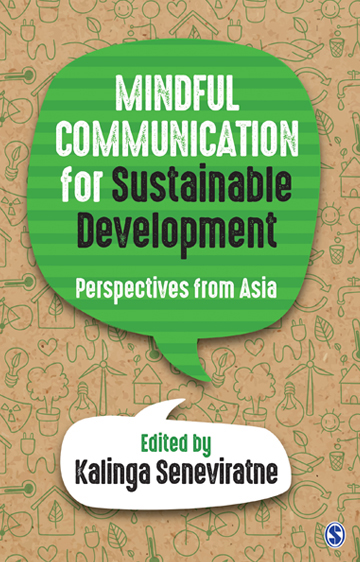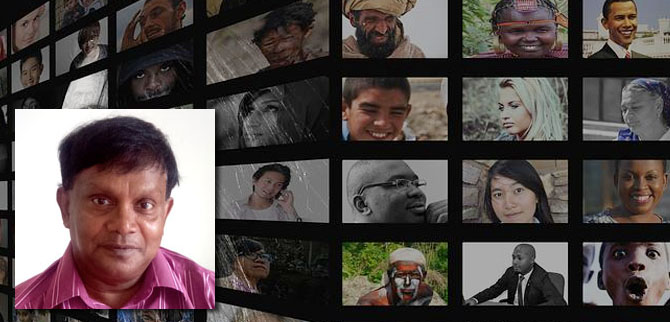Developing a “Human-centric” Journalism Practice by Dr Kalinga Seneviratne
Kalinga Seneviratne is Lecturer in the Faculty of Communication Arts, Chulalongkorn University, Bangkok. He is a media analyst with many years of experience in journalism. He was the Australia and South Pacific correspondent for the Inter Press Service news agency. From 2005 to 2012, he was the Head of Research at the Asian Media Information and Communication Centre, Singapore. Dr Seneviratne has been an award winning radio broadcaster in Sydney. He received the Media Peace Award (1987) from the United Nations Association of Australia and the Educational Award (1992) from the Community Broadcasting Association of Australia. He writes for several news services and has several published works to his credit. Before joining the Faculty of Communication Arts at Chulalongkorn University, Dr Seneviratne taught development journalism and international communications at Macquarie University, Sydney; University of Technology Sydney; Ngee Ann Polytechnic, Singapore; and Nanyang Technological University, Singapore.
SAGE India: https://in.sagepub.com/en-in/sas/mindful-communication-for-sustainable-development/book261649
SAGE UK: https://uk.sagepub.com/en-gb/eur/mindful-communication-for-sustainable-development/book261649
SAGE US: https://us.sagepub.com/en-us/nam/mindful-communication-for-sustainable-development/book261649
 The new title Mindful Communication for Sustainable Development: Perspectives from Asia released by SAGE is a result of an UNESCO-IPDC funded project implemented by Chulalongkorn University in Bangkok to incorporate Asian philosophical concepts into a journalism curriculum. I offered this project proposal to Chulalongkorn University and UNESCO about 4 years ago after seeing how tertiary institutions in Asia teach mass communications and journalism straight out of American textbooks written for American universities, that basically ignores the realities, cultural norms and philosophical/cultural perspectives from Asia. Thus young communicators graduating from Asian universities look up to the West, mainly to the US, for solutions to their communication problems and are not encouraged to look within for solution that are culturally more sensitive and understanding of the Asian socio-economic realities. One could argue that the book is geared to “de-colonise” the minds of Asian communication lecturers as well as their students.
The new title Mindful Communication for Sustainable Development: Perspectives from Asia released by SAGE is a result of an UNESCO-IPDC funded project implemented by Chulalongkorn University in Bangkok to incorporate Asian philosophical concepts into a journalism curriculum. I offered this project proposal to Chulalongkorn University and UNESCO about 4 years ago after seeing how tertiary institutions in Asia teach mass communications and journalism straight out of American textbooks written for American universities, that basically ignores the realities, cultural norms and philosophical/cultural perspectives from Asia. Thus young communicators graduating from Asian universities look up to the West, mainly to the US, for solutions to their communication problems and are not encouraged to look within for solution that are culturally more sensitive and understanding of the Asian socio-economic realities. One could argue that the book is geared to “de-colonise” the minds of Asian communication lecturers as well as their students.
The project included a two-day seminar of Asian communication and philosophy scholars in December 2015 to discuss and focus on Asian philosophical ideas/concepts that come from Buddhist, Hindu and Confucius teachings that could be used in drafting the curriculums. After the curriculums were drafted by a team of lecturers based at Chulalongkorn University, we organized a weeklong workshop in July 2016 for communication lecturers from across Asia to introduce the curriculums and fine tune it for use in Asia. This, book is a result of this workshop and the curriculum development process. The chapters are written by those who were involved in the seminar and workshop.
Many of us felt that the style of journalism practiced in Asia – which has been borrowed from the West – is too adversarial and focus on conflicts rather than helping to solve the social, economic and environmental problems facing humankind. Thus the news media is making people depressed rather than giving them hope for the future. With the United Nations promoting sustainable development, we felt that there is much to learn from ancient Asian philosophical teachings that could be adopted in communicating for sustainable development such as mindfulness, sufficiency economics and paths of understanding and addressing issues of unsatisfactoriness known as ‘dukka’ in Buddhism. All these concepts are secular in nature and you do not need to become a Buddhist or Hindu to adopt these ideas in your journalism and communications practices to promote sustainable development.
As I pointed out in the preface, the word ‘development communication’ was coined in the 1960s and 70s mainly by western scholars, where the western model of development was seen as universal. The communicator was supposed to wean away the peasants from their traditional lifestyles into a more consumption-oriented society. So tradition became old fashioned and greed became development/modernization. The East was supposed to embrace West’s wisdom and discard their ‘mythologies’. But today, in the second decade of the 21st century, especially after the economic crisis in the West questioned this consumerist development model, Eastern ‘mythology’ is now becoming modern wisdom. Yet, East is also following the consumerist model of development that is resulting in much social and environmental damage across the region, while at the same time millions of people are ‘enjoying” the middle class consumerist lifestyles. This book is designed to address this dilemma of development and communicating a future development model that is economically, socially and environmentally sustainable, drawing ideas from eastern philosophical thought.
Mindfulness is today the biggest fad sweeping across the West – particularly the U.S. – we in the East have known this as Vipassana Bhavana for the past 25 centuries. Right at the beginning of the book we have made it clear that mindfulness should not be seen as merely training your mind to be in the present and be focused. This focus has to be accompanied by the development of compassion and loving kindness towards humanity, especially towards the less well-to-do about whose welfare the sustainable development communicators should be focused on.
In chapter 2, Bhikkhu Phuwadol Piyasilo, a Thai forest monk and a mass communication graduate warns that secularizing of mindfulness as practiced in the West could be harmful to humanity as it could create a wrong self-centred focus. He argues that mindfulness needs a moral framework so that it could work with communication itself. He says, as Buddhists we can look at how we analyse suffering and help other people to reduce their sufferings in everyday life. So this is something we can contribute to making communications better. Not promote more conflicts and sufferings.
In chapter 3, Thai social critic Sulak Sivaraksa also warns about using mindfulness in a selfish way to improve your concentration (focus) but not caring about the injustices and suffering in the society. He argues that the global and local economic systems are based on “structural violence’ and mindful communication need to develop a mindset of focusing on such violence (which need not be expressed in overt violence that the media is good at reporting) if we are to promote sustainable development that benefits the poor. Sivaraksa expressed this danger of mindfulness very clearly, thus:
Without a sense of universal responsibility, corporate CEO and others will relieve stress and focus their minds so that they can be more clever businessmen and make more money without improving themselves or the world. Mindfulness without ethics will reduce stress and focus their minds to pursue corporate goals including activities that would promote pollution of the environment and ultimately result in global warming. These type of practices have the potential to building a world facilitating more greed and delusions.
The above quote is reflective of the major theme of the book, which attempts to develop a new generation of development communicators with a new paradigm that incorporates compassion and kindness. In chapter 5 Korean Professor Kwangsoo Park in presenting a Confucius view of communications also discuss the need to address the injustices of the global economic system and the need for journalists to bring in new “ethical values” to the practice of journalism, especially in reporting economic issues. “A goal of journalism is to stimulate harmony among people by encouraging them to celebrate diversity while at the same time realizing the common thread that connects them all,” he argues, adding: “When Confucius discussed ambition with his students he did not suggest that higher your ambition the better.”
A major aspect of the journalism curriculum that was developed for the project was what we call the “human-centric journalism” which is explained in chapters 8, 9 and 10 by Thai communicators Jirayudh Sinthuphan, Suppapron Phokaew and Pipope Panitchpakdi. These include creative research methodologies incorporating mindful compassion concepts that includes training future communicators with deep listening techniques (which could include meditation sessions during journalism classes), a ‘Kalama Sutra’ (charter of free inquiry) model of new journalism, which may not be all that different to the western model of investigative journalism.
Bhutanese communication specialist Dorji Wangchuk discusses in chapter 12 a “middle path journalism” model that incorporates the Gross Happiness Index model the tiny Buddhist kingdom introduced to the world. In discussing economic and development communication many of the authors have reflected upon the Buddhist concept of ‘sufficiency economics’ which was initially mooted by the late Thai King at the height of the 1997 Asian Financial Crisis, which now encompasses many of the Sustainable Development Goals of the UN.
Chapters from Filipino and Malaysian communication scholars focus on the adoption of mindful communication techniques in analyzing media reporting such as President Duterte’s ‘war on drugs’ and socio-religious conflicts in a multicultural society such as Malaysia. Their findings would have lessons for journalists – both in the East and West – on analyzing and reporting conflicts from a people-centric perspective rather than just focusing on the violence and its perpetuators.
Chapters by Sanjay Ranade from India and Kanako Wanatabe from Japan reflects some interesting Asian ways of communication that needs an understanding of the cultural norms of the society to interpret its message and meaning. As Wanatabe discuss, even silence could mean something, while emotions and taste could also be communication methodology in the Asian context as Ranade discuss. The book is basically an attempt to open up the minds of Asian communicators in particular, to wean them away from the adversarial model of journalism, which may sometimes be termed as “watchdog journalism”. But, the book, while not rejecting this notion, tries to make the point that being “watchdog” need not be a negative form of communication. As Panitchpakdi notes in chapter 10, “news has to be critical, but being critical doesn’t have to be confrontational. Being critical is looking at it objectively but the approach of doing it doesn’t have to be negative”.
© Kalinga Seneviratne


